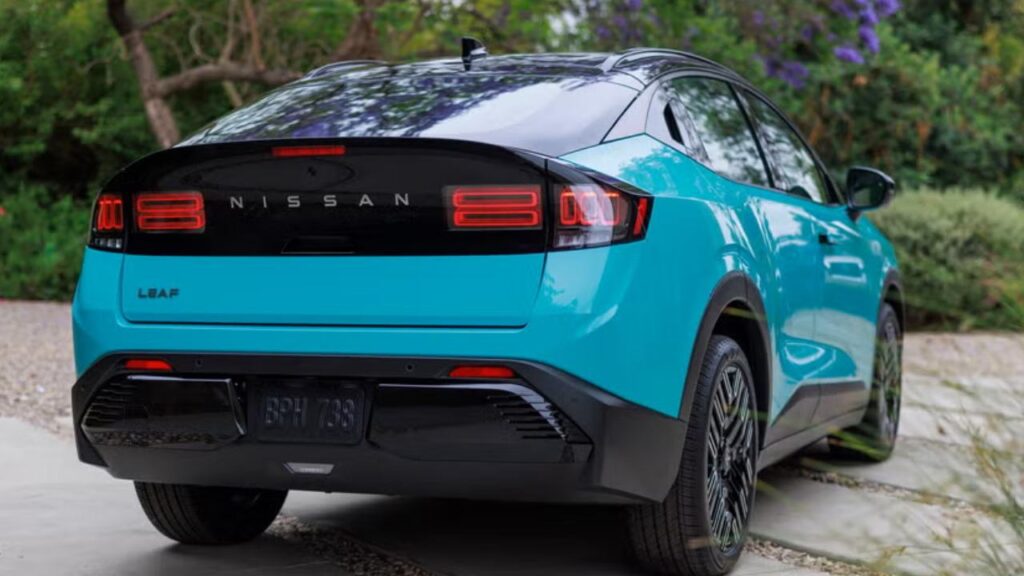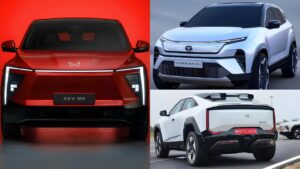Nissan Leaf 3.0 (2026): The recently unveiled third-generation Nissan Leaf features significant upgrades, including a new EV powertrain, advanced driver-assistance features, and a redesigned, more spacious interior features an attractive, bold design and emphasizes both performance and practicality for long-distance travel.
Nissan Leaf 3.0 (2026)
| Feature | Details |
|---|---|
| Model | Nissan Leaf 3.0 (2026) |
| Launch Year | 2026 |
| Body Type | 5-Door Hatchback |
| Battery Capacity | 65 kWh (Expected) |
| Range (Full Charge) | Up to 450 km (WLTP Estimated) |
| Motor Power | 160–180 hp (Expected) |
| Top Speed | Approx. 160 km/h |
| 0–100 km/h Acceleration | Under 7.5 seconds |
| Charging Time | 80% in ~30 mins (DC Fast Charging) |
| Autonomous Features | ProPILOT Assist 2.0 (Updated) |
| Infotainment System | 12-inch Touchscreen, Android Auto & CarPlay |
| Price Range (Expected) | ₹28–35 Lakhs (India), $30,000+ (Global) |
| Rivals | Hyundai Kona EV, MG ZS EV, BYD Dolphin |
The 2026 Nissan Leaf gets a major makeover. The original Leaf was a pioneer in EVs, but was quickly overtaken by newer EVs due to its poor styling and short range.
For 2026, the Leaf has been transformed into a slippery-looking subcompact crossover with a claimed range of over 300 miles in its most efficient trim, charging flexibility, and a stylish design inside and out.
We expect it to start below $40,000 when it goes on sale later this year.
Also Read: Jaguar GT EV 2026 Unveiled: The Electric Supercar That Could Kill Tesla?
Feature and Tech
You might think the new Leaf SUV is bigger than the hatchback it replaces, but its 173.4-inch length is 3.0 inches shorter than before. The 105.9-inch wheelbase is also four-tenths shorter than the 2025 model.

Overall, the 2026 Leaf’s design is fluid and aerodynamic, with Nissan using a sloping fastback roofline, retractable door handles, and a flat underbody, achieving a drag coefficient of just 0.26 (the previous Leaf had a drag coefficient of 0.29).
Design and Style
The design theme that Nissan calls “2-3” is seen throughout the car, with two horizontal rectangles next to three vertical rectangles. This references the company’s name, as “two-three” is pronounced “nee-san” in Japanese.

This motif appears in the lighting, on the wheels, in the cabin, and on the charge-port door.
Up front, sharp LED headlights meet to give the Leaf a slight smile beneath a glossy black panel that can house optional full-width running lights and an optional illuminated Nissan logo.
A sharp character line runs down the side of the car from the front fender, while another crease flows from the front bumper into the wheel arch.
At the rear, a large gloss-black panel forms a small lip spoiler and houses the taillights. On the top Platinum+ trim, these taillights feature a neat 3-D hologram effect, while lesser Leafs display a more conventional look.
Engine and Performance
The all-new Nissan Leaf features a 3-in-1 electric power train, consisting of an integrated motor, inverter, and reducer. This new system is 10% smaller than the previous generation and offers different power and torque outputs depending on the battery option.
Power and Torque:
The 52 kWh battery delivers 130 kW (174 hp) and 345 Nm (254 lb-ft) of torque. The 75 kWh battery option boosts power to 160 kW (214 hp) and 355 Nm (261 lb-ft).
PERFORMANCE IMPROVEMENT:
The new powertrain, combined with Nissan’s Motor Control Technology,y aims to deliver a smooth and responsive driving experience.
Battery Options:
The new LEAF offers a choice between a 52 kWh and 75 kWh liquid-cooled lithium-ion battery.
Acceleration:
Although it’s not a sports car, the LEAF delivers a fun driving experience, with the more powerful motor achieving 0-60 mph in 7.9 seconds.
Range:
The 40 kWh batteries in the previous generation LEAF offered 168 miles on the WLTP cycle. New models with a larger battery pack will offer significantly more range, details of which will be revealed soon.
Price and Variant
Although exact figures aren’t yet known, the old model was priced at just under £29,000, and due to inflation, new battery technology, and internal upgrades, the new model is expected to start at around £33,000.
In India, it is expected to be priced between ₹15.00 lakh and ₹20.00 lakh (ex-showroom). The Nissan Leaf will be available in multiple configurations, which will likely vary in battery size, range, and features. For instance, the third-generation model has an electric range of up to 485 km.




